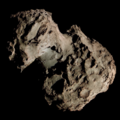Comet Wells, formally designated as C/1882 F1, is a parabolic, sungrazing comet that became visible in the naked eye during the early months of 1882. However, unlike the great comet that appeared later that September, it never became prominent enough to be noticed by the general public due to unfavorable positions in the twilight sky.[5] It is the only comet discovered by American astronomer, Charles S. Wells.
Discovery and observations
The comet was discovered from photographic plates taken by Charles S. Wells on the morning of 18 March 1882, a first for the Dudley Observatory in Albany, New York.[6] The observatory's director, Lewis Boss, described the find as a "small and bright" object in the constellation Hercules.[a]
The comet was further observed telescopically throughout April 1882 as it gradually approached the Earth.[7] It reached naked-eye visibility the following month as it became a 4th-magnitude object, and was briefly thought to be the same comet observed during the total solar eclipse of 17 May 1882 until later reanalysis revealed it was a different object, now known as X/1882 K1 (Tewfik).[8]
In June 1882, the comet rapidly brightened as it approached perihelion, increasing its brightness to magnitude 0, and a tail measuring 5 degrees in length.[3] However, it never became prominent enough to attract widespread public attention due to it being only briefly observable for brief periods in twilight.[5] Despite this, several astronomers did manage to see the comet in broad daylight, by this time it has reached its peak magnitude of –6.0, making it one of the brightest comets ever recorded alongside the later Great Comet of September 1882.[9][3]
See also
- X/1882 K1 (Tewfik)
- C/1882 R1, also known as the Great Comet of 1882
References
Notes
Citations
- ^ "Comet Names and Designations". International Comet Quarterly. Retrieved 9 December 2024.
- ^ "C/1882 F1 (Wells) – JPL Small-Body Database Lookup". ssd.jpl.nasa.gov. Jet Propulsion Laboratory. Retrieved 16 December 2024.
- ^ a b c J. E. Bortle (1998). "The Bright Comet Chronicles". International Comet Quarterly. Retrieved 16 December 2024.
- ^ a b G. W. Kronk (2003). Cometography: A Catalog of Comets. Vol. 2: 1800–1899. Cambridge University Press. pp. 496–498. ISBN 978-0-521-58505-7.
- ^ a b A. M. Clerke (2010). A Popular History of Astronomy During the Nineteenth Century. Cambridge University Press. pp. 398–400. ISBN 978-1-108-01432-8.
- ^ G. Wise (2004). Civic Astronomy: Albany's Dudley Observatory, 1852–2002. Astrophysics and Space Science Library. Vol. 316. Springer. pp. 69–70. doi:10.1007/978-1-4020-2678-2. ISBN 978-1-402-02678-2.
- ^ "Comet a 1882". Scientific American. Vol. 46, no. 15. April 1882. p. 224. doi:10.1038/scientificamerican04151882-224a. JSTOR 26077722.
- ^ G. W. Kronk. "X/1882 K1 (Eclipse Comet or "Tewfik")". Cometography.com. Retrieved 5 November 2024.
- ^ J. Atanackov [@JAtanackov] (September 30, 2024). "There is a small possibility that in October we may get *two* comets visible in broad daylight. Such comets are rare, with ~10 such known cases in the past 200 yrs. The closest were C/1882 F1 (Wells) & C/1882 R1 (Great September Comet), about 3 months apart. But two in 3 weeks?" (Tweet) – via Twitter.
External links
- C/1882 F1 at the JPL Small-Body Database











You must be logged in to post a comment.